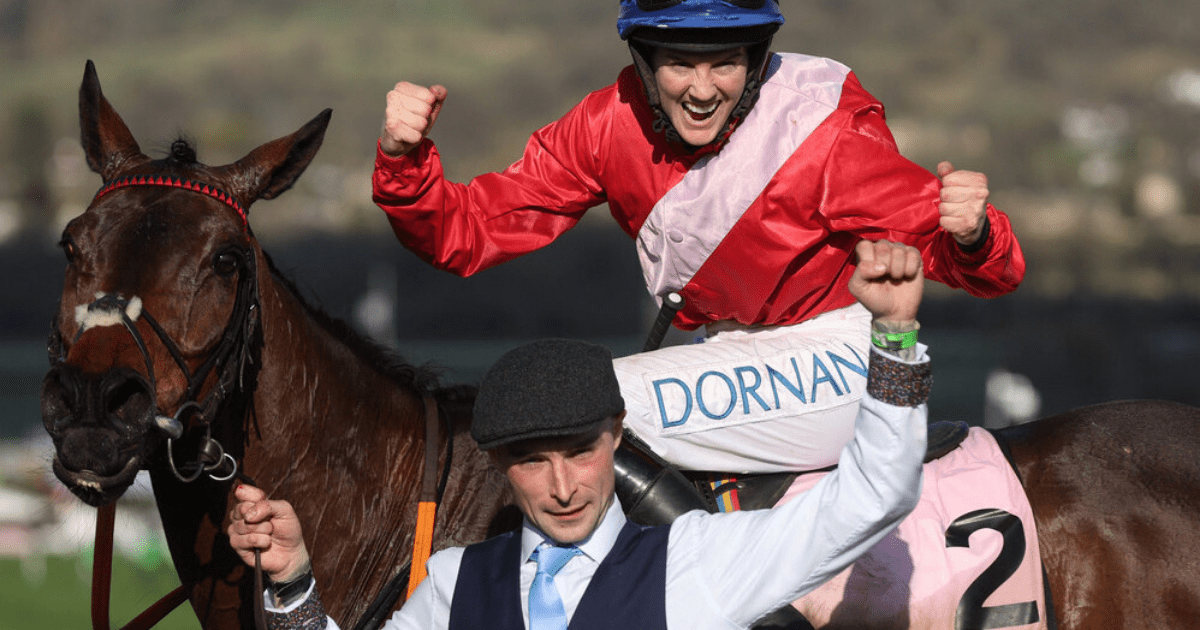Rachael Blackmore's superstar horse has been retired
Rachael Blackmore's Gold Cup-winning horse, A Plus Tard, has officially been retired from racing, according to a statement by Richard Thompson, director of owners Cheveley Park Stud. A Plus Tard, who helped propel Blackmore to global fame, claimed the prestigious Gold Cup title in 2022, triumphing over Minella Indo by 15 lengths. The ten-year-old has amassed over £950,000 in prize money and secured four Grade 1 victories, including two wins at the Cheltenham Festival.
An Emotional Journey
In a heartfelt statement, Thompson shared the emotional story behind A Plus Tard's retirement. He revealed that his father had devised a plan in early 2018 to purchase National Hunt horses to be trained in Ireland with the ultimate goal of winning the Cheltenham Gold Cup. Over four years later, that dream became a reality when A Plus Tard, ridden by Rachael Blackmore, clinched victory at the first Cheltenham Festival post Covid, in front of a crowd of 70,000 spectators.
A Bittersweet Victory
Thompson went on to recount the poignant moment when his father watched A Plus Tard win the Savills Chase in December 2020, only to pass away the following day. It was the last horse race his father ever witnessed. A Plus Tard holds a special place in the hearts of the Thompson family, as he was the first horse to win the Cheltenham Festival in the red, white, and blue colors of Cheveley Park Stud. Additionally, he marked Rachael Blackmore's first Cheltenham victory in the 2019 Listed Close Brothers Novices' Chase.
A Plus Tard's Legacy
A Plus Tard's retirement marks the end of an era and a remarkable chapter in the history of Cheveley Park Stud. The horse's achievements, combined with the emotional journey he took the Thompson family on, ensure that he will always hold a special place in their hearts.
Stay tuned for more updates.
Frequently Asked Questions
What is the first step in training a racehorse?
In the initial training phase, the racehorse must undergo a crucial stage called “breaking,” during which the horse is accustomed to the saddle, the bridle and the weight carried by the rider. During these early sessions, patience and gentle handling are paramount to ensure the horse learns to be comfortable with human interaction and the equipment it will wear throughout its racing career.
What is the importance of a horse’s pedigree to racing success?
While pedigrees can be used as a predictor of potential in a racehorse, they are not the only factors that influence their performance. The lineage of a horse may indicate an inherited ability for speed or endurance. However, training, health and temperament can also be influential factors. Good training will maximize a horses natural abilities and may even enable it to outperform those with more impressive bloodlines.
How often are racehorses trained?
The frequency of training for racehorses depends on the horse’s individual needs, fitness level, and racing schedule. Typically, they would have a daily routine consisting of exercise such as walking, trotting, and cantering, with more exertive work such as galloping or breezing several times a week to build stamina and speed. Rest days allow the horse time to recover from training and to avoid overtraining.
What age should a race horse start training?
While horses can begin basic race training as young yearlings (or even younger), most start their more intensive training when they reach two years of age. The horses’ bodies will be mature enough to withstand the strain of racing, while still young and adaptable. However, the exact timing may vary depending on the individual horse’s development and temperament.
Do different breeds of horses require different training methods?
Race training methods can indeed vary for different horse breeds, as breed characteristics and racing distances differ. Thoroughbreds which are associated with long distance flat racing undergo different training to Quarter Horses which specialize in sprinting over short distances. Each breed has unique physical and behavioral traits that require a tailored training approach.
Can you train your racehorse anywhere?
Although initial training can be done on any track, race-specific training is often required in facilities that mimic the conditions the horse may face during competition. This means that you need to have tracks that are of the correct size, with the same kind of surface your horse will be racing. It is important to use the right track in order to condition the horse correctly and familiarize them with the particular racing environment.
Statistics
- Research has found that a racehorse’s stride length can increase by up to 7% following specific strength and conditioning programs.
- An extensive survey indicated that over 90% of racehorse trainers utilize swimming as a low-impact exercise in their conditioning routines.
- Around 80% of thoroughbred racehorses begin their racing careers by the age of two, according to industry estimates.
- Statistically, less than 1% of thoroughbred foals born each year will go on to win a stakes race.
- The majority of racehorses in training are subject to an exercise regimen that includes being ridden six days a week.
- Gastrointestinal issues affect up to 90% of racehorses during their training, emphasizing the need for careful dietary management.
External Links
horseracing.com
bloodhorse.com
grayson-jockeyclub.org
thoroughbredracing.com
paulickreport.com
thoroughbred-racing.net
How To
How To Train A Young Racehorse
Start the training process of a young racing horse with an emphasis on trust and familiarity. Introduce a horse to a bridle (or saddle), and let it feel the weight of a rider. You can start by teaching the horse to walk, stop and turn. Next, you can progress to trotting. Consistency, patience, and gentle reinforcement are important.

